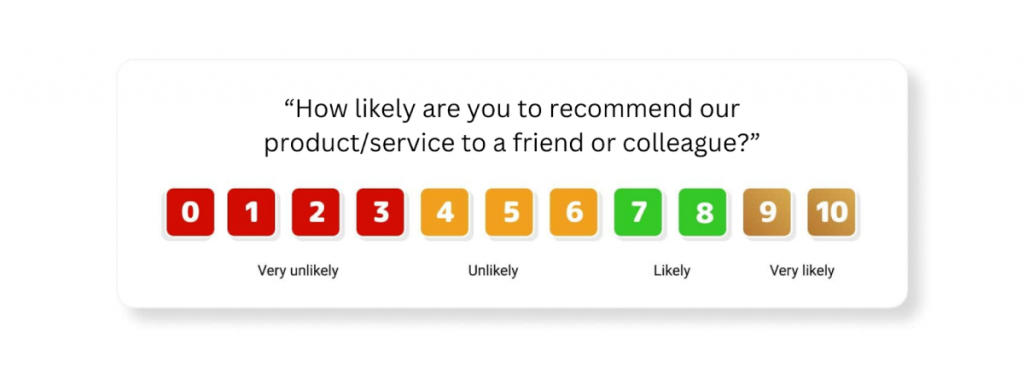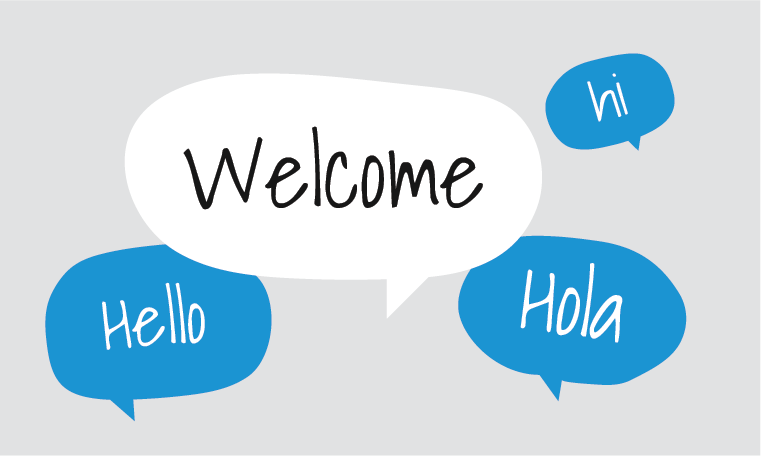“Opportunities don’t happen. You create them” – Chris Grosser
This quote rings true when it comes to lead generation!
Lead generation is all about seizing opportunities and turning them into real possibilities. Think of it as your strategic tool for transforming interest into action.
Now you must be thinking: But what exactly is lead generation? How does it work? Why is it so crucial for your business? And how can you harness its power to drive growth?
If your mind is bombarded with all these questions, just take a breather and read this guide, which includes everything from the basics to key lead generation strategies.
What Is Lead Generation?
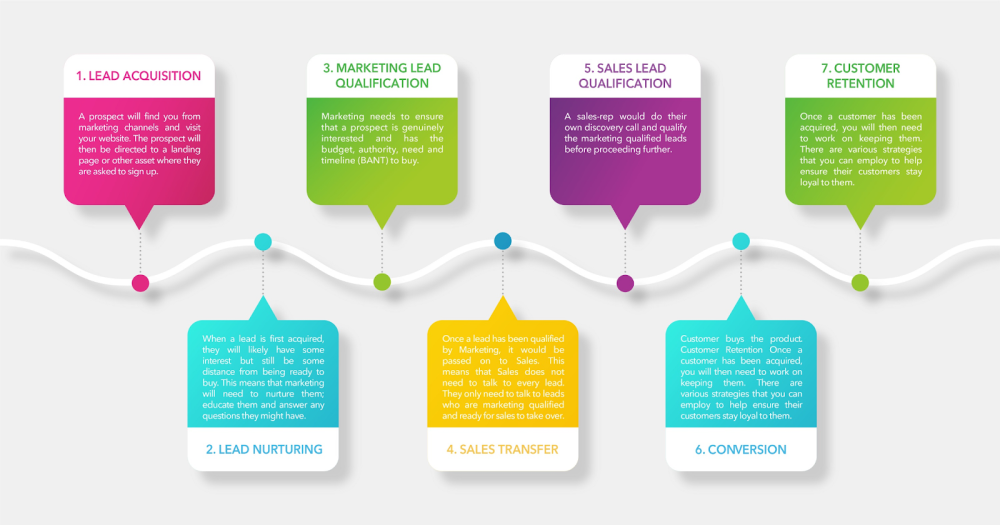
Lead generation is the process of attracting and identifying potential customers for your business. It involves creating interest in your products or services and converting that interest into actionable leads. These leads are potential customers who have shown some level of interest or engagement with your brand.
The lead generation process aims to build a pipeline of prospects that can be nurtured and eventually turned into loyal customers. Robust lead generation strategies can include a mix of content marketing, social media outreach, email campaigns, and paid advertising.
When you get a better idea of who your ideal customer is and focus on them, you attract better leads and grow your business.
Simply put, lead generation isn’t just about attracting attention—it’s about creating opportunities and guiding potential customers through the journey from curiosity to commitment.
Why Do You Need Lead Generation?
Lead generation is key for businesses to locate and connect with people who may want their products or services. Here’s why it’s important:
- Skyrocket Your Sales
Lead generation ensures a constant stream of potential customers interested in what you offer. This translates to more chances for sales and revenue growth. Consistently attracting interested prospects boosts your chances of closing deals and improving your overall sales performance. - Get Noticed
Effective lead generation strategies, like engaging content and active social media presence, help elevate your brand’s visibility. As you reach more people and create a stronger online presence, your brand becomes top-of-mind for potential customers when they are ready to make a purchase. - Save Money
Targeted lead generation focuses marketing efforts on high-potential prospects, minimizing wasted time on less effective tactics. By concentrating resources on reaching those most likely to convert, you improve your return on investment (ROI). This means you get more value from your marketing budget and achieve better results. - Fuel Growth
A steady stream of new leads is vital for business growth. By consistently attracting and nurturing new prospects to find B2B leads, you maintain a full sales pipeline and ensure your business continues to expand. This ongoing influx of potential customers helps you scale your operations and reach your growth objectives. - Learn About Your Market
Leads provide critical insights into your customers’ preferences, challenges, and behaviors. Analyzing this data helps you refine your marketing strategies, tailor your product offerings, and address your customers’ needs more effectively. Understanding what drives your leads allows you to make informed decisions and improve your overall approach.
Lead generation is essential for driving business growth, increasing sales, and building a strong market presence. By focusing on generating high-quality leads, you can create a sustainable path to success and ensure your business remains competitive and thriving.
How to Generate Leads
Generating leads involves attracting potential customers and nurturing them to ultimately convert them into paying clients. Here’s a streamlined approach to generating leads:
- Understand Your Target Audience
Start by clearly defining who your ideal customers are. Research their demographics, interests, and pain points. Creating detailed buyer personas can help you tailor your marketing strategies to effectively address their needs and preferences. - Create Compelling Content
Develop high-quality content that provides value to your target audience. This can include blog posts, eBooks, infographics, videos, and case studies. Your content should be informative, engaging, and relevant, aiming to solve problems or answer questions your audience may have. - Utilize Social Media
Engage with your audience on social media platforms like Facebook, LinkedIn, Twitter, and Instagram. Share valuable content, run targeted ads, and interact with your followers. For instance, many businesses utilize LinkedIn for B2B lead generation. - Optimize Your Website
Ensure your website is user-friendly, visually appealing, and optimized for search engines. Implement clear calls-to-action (CTAs) and create dedicated landing pages designed to capture lead information. Make sure your site loads quickly and is mobile-responsive. - Leverage Email Marketing
Build and maintain a targeted email list. Segment your audience based on their interests and behaviors to send personalized and relevant content. Regularly send out newsletters, promotional offers, and updates to nurture leads and keep them engaged. - Implement Lead Magnets
Offer valuable incentives to encourage visitors to provide their contact information. This could be in the form of free trials, downloadable white papers, exclusive webinars, or discount codes. Ensure that your lead magnets are relevant and enticing to your target audience. - Network and Partner
Actively participate in industry events, webinars, and conferences to meet potential leads and build relationships. Collaborate with other businesses, influencers, or thought leaders to expand your reach and tap into new audiences. - Use Paid Advertising
Invest in paid search and social media advertising to drive targeted traffic to your lead capture pages. Utilize lead generation tools like Google Ads or Facebook Ads to create highly targeted campaigns based on user demographics, interests, and behaviors. - Monitor and Analyze
Regularly track and analyze your lead generation efforts using analytics tools. Assess which strategies are yielding the best results and where there is room for improvement. Use this data to refine your approach and optimize your lead generation tactics.
Incorporating these detailed strategies while keeping a strong focus on your target audience will enable you to effectively generate and nurture leads. This approach not only attracts potential customers but also fosters their engagement, ultimately driving business growth.
Key Lead Generation Marketing Techniques & Examples
Successful lead generation is a must-have for any business to thrive, and having a well-rounded marketing strategy is essential for capturing and nurturing potential customers. Here are some tried and tested lead generation marketing strategies and examples to consider:
1. PPC (Pay-per-Click)
With everything going online, it’s easier to collect customer information, but it should be in exchange for personalized and ethical marketing. PPC lead generation technique is about showing ads on Google searches (SERPs).
Given that Google gets about 3.5 billion daily searches, it’s a good platform to have people see your brand using ad campaigns. So, prepare your PPC strategy with a good budget, seamless user flow, target keywords, and more. Here’s a screenshot illustrating a PPC ad campaign.

FREE. All Features. FOREVER!
Try our Forever FREE account with all premium features!
2. Email Marketing
Email marketing has been a go-to tool for companies to reach out to their customers. To this day, companies are big on email marketing and make use of email finder tools to optimize it
You can send in event invites such as webinars, personalize your emails while sending promotional content, and just keep in touch while updating them on new things. It’s an excellent way to send content to prospects who may not be looking for you and turn them into quality leads.
Let’s take Neil Patel as an example. He uses email marketing to introduce customers to new events, such as webinars, and encourages them to sign up.
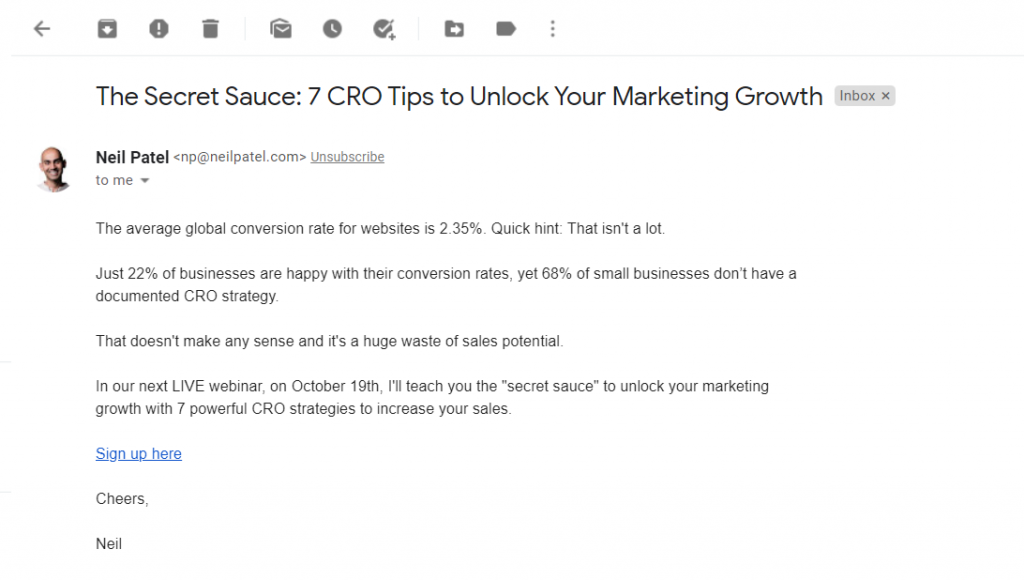
3. Content Marketing
As per the Content Marketing Institute, content marketing is “the marketing technique of creating and distributing relevant and valuable content to attract, acquire, and engage a clearly defined and understood target audience — with the objective of driving profitable customer action.”
Like any lead generation channel, you need a clear strategy to benefit from content marketing.
So, what elements can make this channel your top lead generator?
- Topics your target audience will eat up immediately.
- Type of content your audience prefers, i.e., short-form and long-form content.
- Channels you use to target your audience such as organic Google searches, social media platforms, partnership with third-party websites, influencer marketing, etc.
It’s best to use a rich mix of short—and long-form visual and written content to capture different audience demographics.
If you target an audience on social media, short-form content will be your holy grail. You can create small videos like reels, digestible infographics, illustrated slides, and stories.
For long-form content, you can create guides, eBooks, detailed articles, educational videos, courses, etc., and publish them on your website and mobile app or partner with third-party websites to widen the audience pool.
To take your game up a notch, you can follow some content marketing best practices like content re-packaging, tracking content performance across all platforms, and, most importantly, gathering customer feedback on content quality.
For example, you can launch pop-up surveys on your article pages, guides, and even eBooks to ask customers what content they need.
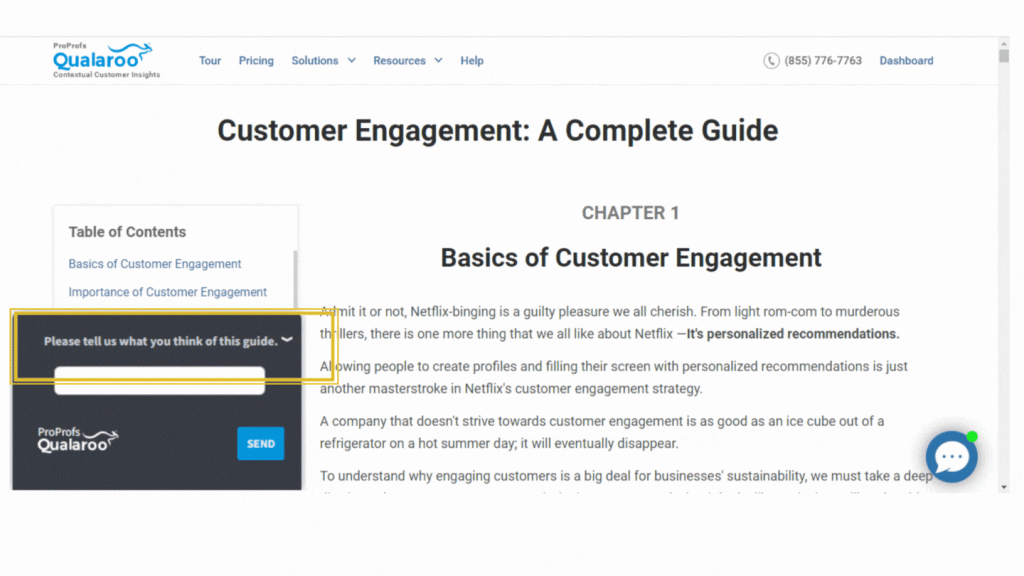
This way, you’ll know if you cover the right content topics and what else you can take up. If done correctly, this channel can:
- Get inbound links
- Social media shares and exposure
- Shape brand preference
- Help you create customer-centric content
- Put you on the map of search engine
- Increase brand awareness
It sounds good, isn’t it?
CASE STUDY: How Udemy improved content through feedback
An online learning platform, Udemy, wanted to understand the success of the newly updated auto-captioning feature for their videos. The team at Udemy launched Qualaroo’s NudgeTM surveys on their platform, asking students about the accuracy of the feature.
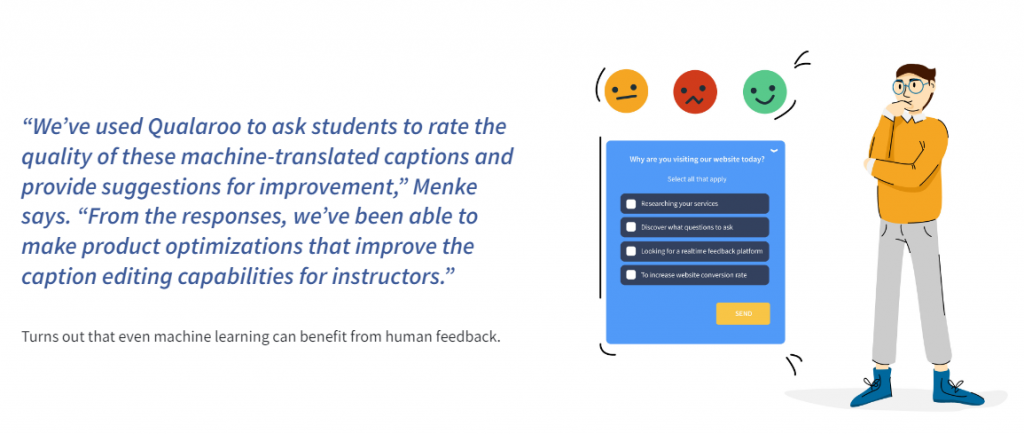
As a result, the team improved the feature to offer accurate captions each time. You can read more about Udemy and how it leveraged feedback here.
4. Influencer Marketing
Influencer marketing has become a marketing juggernaut, thanks to social media’s increasingly critical role in people’s lives.
Leading brands like Gucci, Pepsi, Motorola, and countless others hopped on this bandwagon to reap one of the most significant benefits: Lead generation.
The question is, why is it so effective and popular?
It’s because people (61%, to be precise) still believe in the power of customer reviews and recommendations.
You can partner with influencers that are popular among your target audience to spread brand awareness and attract more leads.
For example, Dior, a high-end consumer brand, bagged a whopping $1.1 million in MIV (media impact value) from a single Instagram post by a singer and influencer, Oh Se-Hun.
5. Live Events and Seminars
Like Neil Patel, many companies opt for this outbound marketing strategy. One of the best ways to actively engage prospects with your brand is to encourage them to participate in events like webinars that they may be interested in.
For instance, you can host offline events such as seminars, conferences, meetups, etc., with guest speakers, but in the post-pandemic era, online events work great too. Also, online events have the potential to reach more people globally.
Hosting events improves brand presence and customer engagement and allows companies to learn about their customers’ interests.
6. Social Media
Since social media is huge, it makes sense to incorporate it into your online lead generation strategy.
- Facebook Leads
Facebook’s Lead Ads are a great tool to find TOFU leads and redirect them toward your website. You can add a CTA to your Facebook page that directly takes visitors to your website. - Twitter Leads
Twitter is another social media platform that helps businesses get and manage leads. It has a Twitter Lead Gen Card feature that generates leads from tweets and pulls out information such as tweeters’ IDs, names, and Twitter usernames; all they have to do is submit and become a lead.

- LinkedIn Leads
Out of all the social media platforms, LinkedIn has become popular in the professional world with big brands and is now a solid part of their social media campaigns. It offers a feature called Lead Gen Forms to facilitate B2B lead generation on the platform. The form auto-populates with the visitors’ profile information when they click on a CTA; all they have to do is submit. This makes it easy for users to share their information with minimal effort. Additionally, you can export contacts from LinkedIn directly into your CRM systems or marketing platforms. This export streamlines the process of managing and nurturing leads, allowing for more targeted and personalized multi-channel strategies. LinkedIn lead generation has proven to be effective for businesses targeting professionals and seeking quality leads.
How to Qualify Your Leads
Qualifying leads involves evaluating potential customers to determine if they fit your ideal customer profile and are likely to convert into paying customers. Here’s how you can qualify leads:
1. Define Your Ideal Customer Profile (ICP)
- Identify Characteristics: Outline the key attributes of your ideal customer, including industry, company size, job title, and geographic location.
- Understand Pain Points: Recognize the common challenges and needs that your ideal customers face.
2. Use Lead Scoring
- Assign Scores: Create a scoring system based on demographic and behavioral criteria (e.g., job role, engagement level, website visits).
- Prioritize Leads: Focus on leads with the highest scores who are most likely to convert.
3. Assess Fit and Interest
- Qualify Fit: Determine if the lead fits your ICP in terms of company size, industry, and budget.
- Gauge Interest: Evaluate the lead’s interest through their interactions, such as email opens, website visits, and inquiries.
4. Ask Qualifying Questions
- Budget: Inquire about the lead’s budget to ensure they can afford your product or service.
- Authority: Identify if the lead has the decision-making power or is the influencer in the buying process.
- Need: Understand their specific needs and pain points to see if your solution is a good match.
- Timeline: Find out their timeframe for making a decision to ensure it aligns with your sales cycle.
5. Conduct a Needs Assessment
- Deep Dive: Engage in conversations to uncover the lead’s pain points, needs, and goals.
- Solution Fit: Match their needs with your solution’s features and benefits.
6. Review and Adjust
- Track Metrics: Monitor your lead qualification metrics and adjust your criteria and scoring system based on performance data.
- Continuous Improvement: Review and refine your lead qualification process regularly to adapt to changes in your market and offerings.
These steps will help you better identify high-quality leads and focus your efforts on prospects who are most likely to drive revenue.
Tips for Crafting Successful Lead Generation Campaigns
Tracking the performance of your lead generation strategy is crucial for improving it. But how do you do that? – with lead generation metrics.
So, here are a few metrics that help with the lead generation process:
1. Invest in Content – Gated and Otherwise
Think of the internet as a superpower for companies, and with power comes responsibility.
Instead of reciting an overly promotional marketing pitch, offer useful resources such as insightful posts, articles, and blogs educating visitors on useful topics related to your niche.
Creating content that matters to your targeted audience, marketing it properly, and placing it in the right place in your lead generation process will yield astonishing results.
For example, Salesforce has a section called ‘Analyst reports.’ When you land on the page, you can download any report you want.
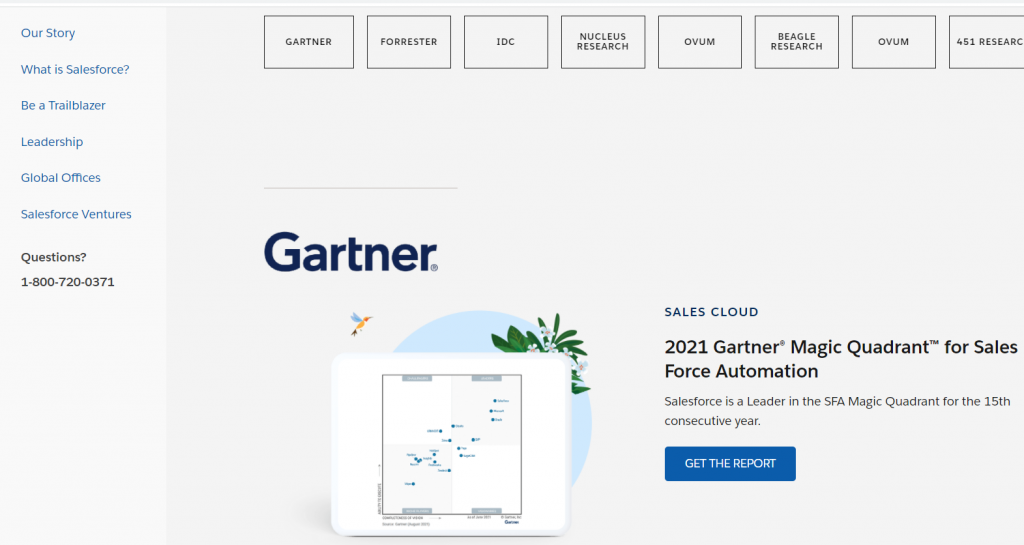
When you click on the ‘Get The Report’ CTA, you will land on the lead generation form page, where you will have to fill in your information to download the report.

So, invest in creating gated content like guides, ebooks, and public content like blogs, articles, and other such resources. These will educate customers about your company and its value offerings and allow you an intelligent way to ask for customers’ information.

It may feel daunting at first to develop or improve your content strategy but asking your target audience what type of content they would like to consume is one of the best ways to go about it. To uncover, you can ask questions like:
- Was this help section useful?
- What topics would you like to see us write about next?
- What other products would you like to see us offer?
- Did this article answer your question?
- Were you able to find the information you were looking for?
- What other information would you like to see on this page?
Besides asking these content-related questions, you can also add surveys to your website to engage visitors and turn them into leads. For example, Qualaroo helps you collect leads with its lead generation form.
Here are a few questions you can ask in a lead gen form your leads to get their information and then target them to turn them into customers.
Example 1:

Example 2:
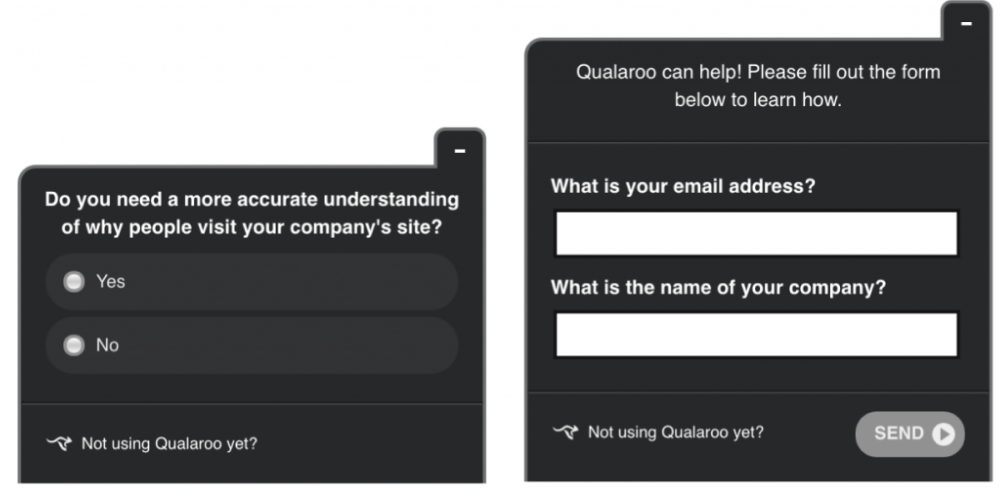
You can also use exit-intent pop-ups to engage your website visitors, stop them from leaving, and eventually collect their information to target them with different marketing campaigns. Tools such as Picreel specialize in this feature.
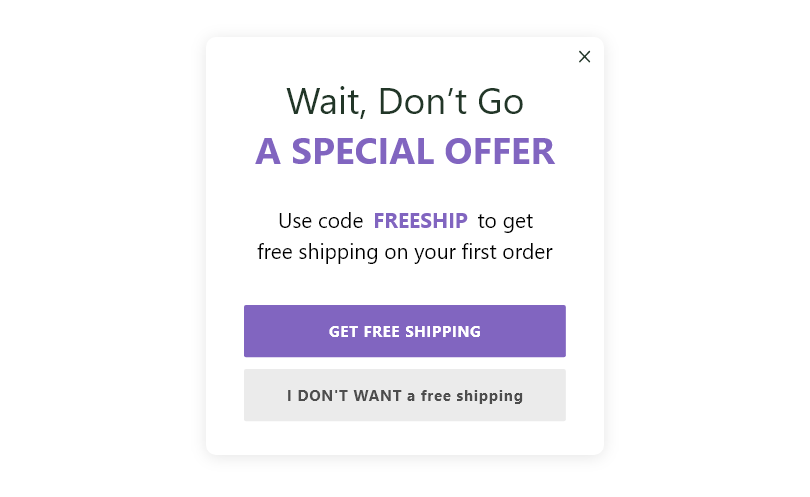
2. Freemium
Freemium and free trial are often used interchangeably but are two different things. For example, a free trial has a time limit during which subscribers can try the product/services for free, and then they can pay for a plan to continue using them.
HubSpot is one example. They offer a 14-day free trial.
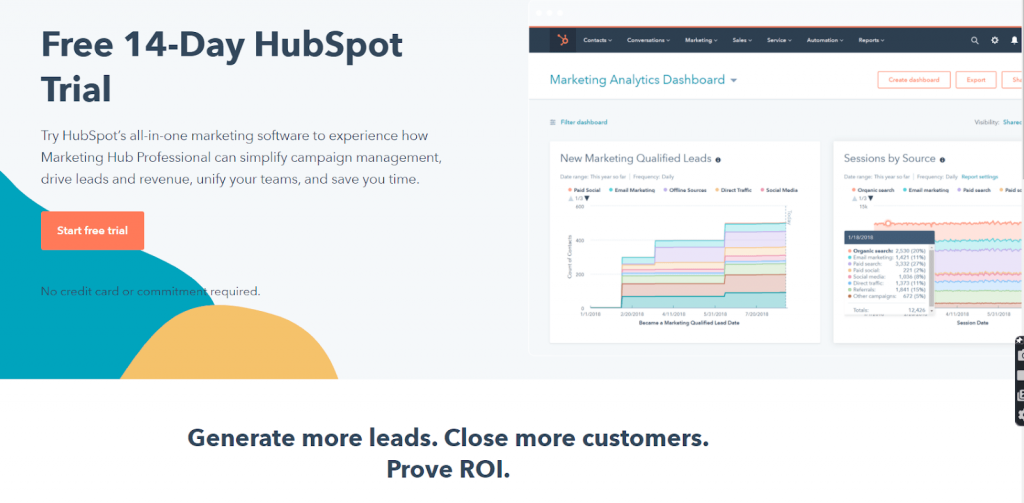
On the other hand, Freemium is a free service or product with basic features. Customers have to pay for a plan to get access to premium features. YouTube is an excellent example of freemium.
There’s no limit to how many videos you can watch or publish (the basic features), but a paid subscription allows you to enjoy ad-free streaming and many other functionalities.
3. Focus on Top-of-Funnel Keywords
If you want to bring in new leads, you need to start from the top, literally. It will help to focus more on TOFU keywords that your target audience generally associates with your product and service.
Once you know what keywords your audience usually uses, you can start targeting them in different ways and create a roadmap that directs your leads towards the lead magnets (there’s no such thing as too many ‘leads,’ not even here).
To target the keywords, you can create keyword-optimized content, create landing pages around those keywords, use the keywords for PPC, push guest blogs, and follow SEO best practices.
[Also check out: The Ultimate Guide to SEO for UX Designers]
4. Marketing-Sales Feedback Loop
As discussed above, a rapport between marketing and sales is crucial for effective lead generation. Creating and maintaining a feedback loop between the two teams is a great way to improve your lead generation campaigns.
For example, if the marketing team sends leads to sales and, in turn, the sales team provides feedback on the lead quality on time, the marketing team can analyze what works and when it needs to tweak its strategy.
If the feedback loop is missing, then marketing will think that all leads they send are converting, so they’ll continue with their existing practices without knowing what’s actually happening between the sales and the leads.
So, what’s to be done?
You can use a CRM like BIGContacts to create a solid feedback loop between sales and marketing. This integrated system can help reduce the communication barrier with its rich features.
For instance, a sales team can follow marketing campaigns to see how the marketing team targets specific leads.
Once the sales team knows how the lead was warmed up, they can personalize their strategies to convert it. Teams can also add notes to specific leads and interactions to maintain the feedback loop.
[Here’s something useful: Top 25+ Lead Generation Tools For Your Business]
5. Listen to Your Customers/Prospects
Businesses can often significantly improve their lead generation strategy by simply listening to their customers and prospects.
How you approach your prospects for feedback will differ from how you do it with customers.
With customers, you can gather information about your brand experience and use the data as customer reviews and testimonials. You can find loopholes in your customer journey and the overall experience to ensure your leads don’t churn away.
As for the prospects or leads, you can collect their feedback on how they come across your brand to strengthen your core marketing sources.
6. A Dedicated Landing Page for Your CTAs
You may think this one is obvious, but it’s not. Unfortunately, many marketers do not create separate and dedicated landing pages for CTAs when they clearly should.
One of the primary purposes of CTAs is to direct customers to a landing page they represent. As a customer, you wouldn’t like to click on a CTA to register for a webinar and just land on the website’s home page.
For example, here’s Mailchimp with its ad campaign for the “Great Landing Page Examples”-
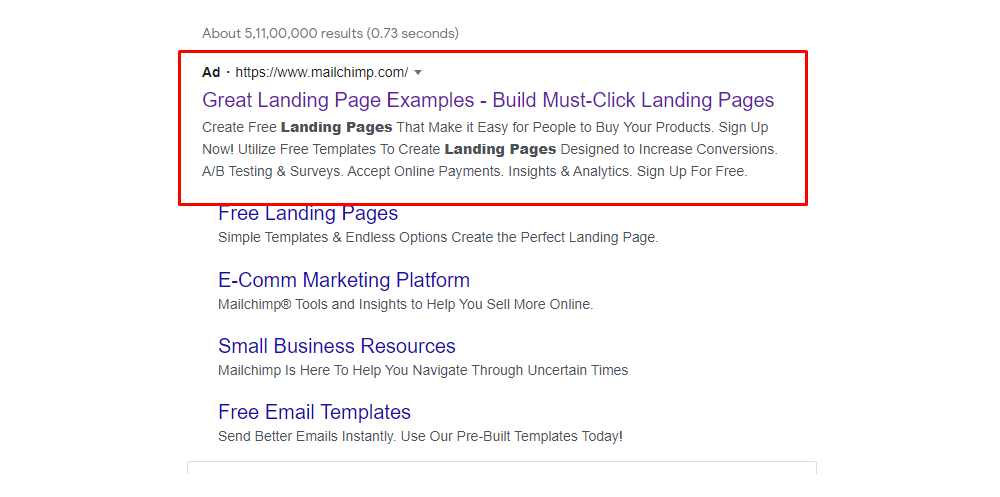
As soon as you click on the ad, you’ll be redirected to a dedicated landing page for the same.
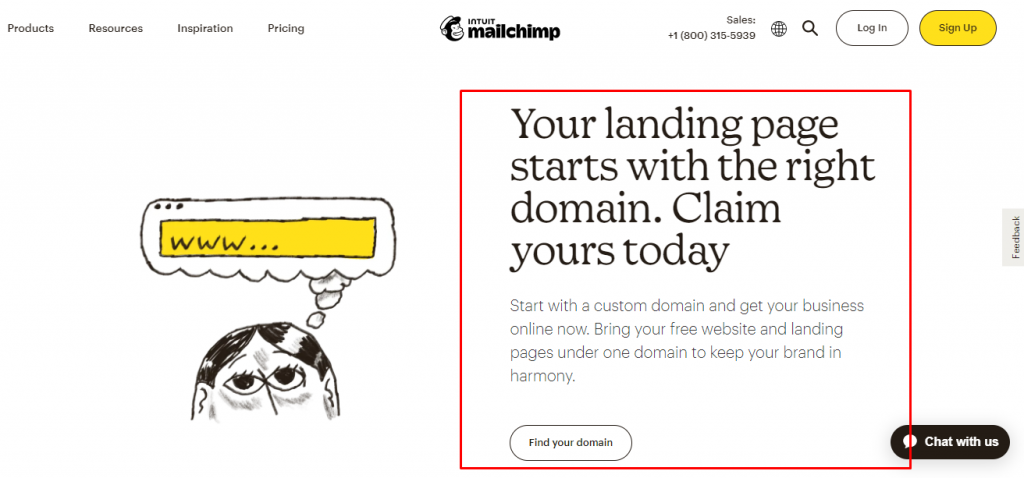
💁♀️Pro Tip: Try not to include multiple CTAs on a single page, as this can distract visitors and create a choice paradox. You can also A/B test your CTAs and launch surveys to ask customers what they think of them. This way, you’ll be able to design CTAs that actually work.
7. Keep Your Messaging Consistent and Deliver on Your Promise
Messaging is crucial for every company, and it is essential to keep it consistent throughout your campaigns and different platforms.
From your ad copy to website design to other media you create to your offerings, everything should be seamless. This ensures a smooth transition of leads to the next stage in the lead generation funnel.
For example, let’s continue the Mailchimp example from above. The landing page for the ad campaign gives the information it had promised with clear CTAs and the messaging is also consistent.
8. Coupons & Discounts
As we briefly mentioned above, you can use discounts, coupons, and deals as lead magnets for your lead generation campaign to attract both long and short-term leads.
In the long term, you can motivate more people to purchase from you, and in the short term, you can convert bottom-of-funnel (BOFU) prospects.
9. Live Chat Software to Always Be There for Customer
Using live chat software allows you, as a company, to always be there for your customers when they land on your website. They can directly ask their queries in the live chat popup and get instant support.
For example, Qualaroo also has a live chat window that opens automatically when a visitor needs assistance.
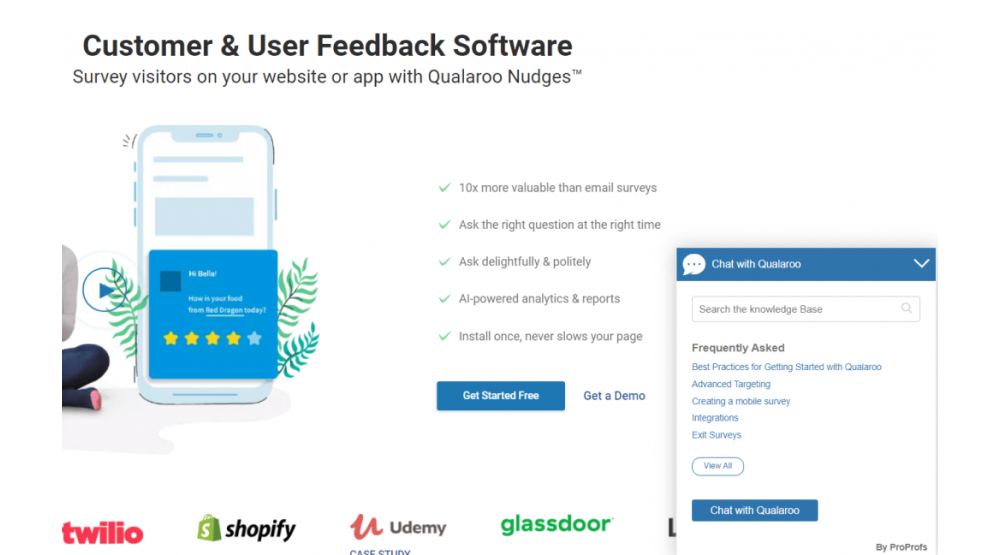
Besides, you can also:
- Shoot pre-chat forms to collect visitors’ information.
- Resolve customer queries related to pricing, checkout, and other early-stage touchpoints in the customer journey with a live chat tool to transform visitors into leads and push them further into the sales funnel.
- Redirect customers to relevant pages to help them reach the end goal – purchase.
10. Lead Scoring
Each company has its own custom parameters for judging lead quality, but a common method used to judge leads on those parameters is lead scoring.
Lead scoring is assigning points and ranking leads based on:
- How far along they are in the sales funnel
- How close they are to purchasing and their interests
You can conduct user research surveys to create buyer personas of your ideal customers and then create a lead scoring system with parameters based on your needs.
Here are some lead generation survey sample questions to create a buyer persona:
- What is your role?
- What is your biggest pain point?
- What does your typical day look like?
- What did you come here to do today?
- What problem does our product solve for you?
- What types of content do you read?
- What tools are you using currently?
- How has this feature impacted your work?
Access this survey question library for more information on this.
A few basic parameters you can consider for your lead scoring system are when the leads:
- Open your email
- Visit your website
- Download resources from your website like ebooks, guides, etc.
- Click on your promotional ad
- Register for a webinar you are conducting
- Subscribe for a free trial
You can assign scores to your leads this way, and the higher a lead’s score, the higher its quality and chances of conversion.
A high-quality lead is generally referred to as a ‘hot’ lead, while a lead with the average score is called a ‘warm’ lead. You can make a warm lead hotter by targeting more marketing campaigns.
11. Boost Engagement Across Channels
enerating leads is all about engaging the target audience and motivating them to interact more with your business.
Your social media marketing, content marketing, and influencer marketing strategies will take care of bringing the leads to your website, but what happens after that?
Once a visitor lands on your website or mobile app, you need to assist them in your customer journey to convert them.
Here are some ways in which you can engage with your leads on the website:
- You can add a live chat tool to assist in resolving queries and helping them navigate. For this, you can use a tool like ProProfs Chat.
- A self-help tool like Knowledge Base takes care of small queries from leads as they can look for any queries without relying on customer support.
- Once visitors arrive on your website, you can engage them using quizzes and collect their information. ProProfs Quiz Maker is a good choice for the same.
12. Streamline Your Sales Pipeline
When you get a lead, either through a sign-up CTA, Demo CTA, live chat, or survey feedback, there is much to do. You need to manage and streamline your sales pipeline to keep track of every lead and ensure they don’t drop out.
Customer relationship management (CRM) tools such as BIGContact help you track each lead so you can customize your sales strategy and ensure they convert.
With these tips, you can create more effective lead generation campaigns that drive better results and grow your business.
Before moving forward, let’s take a closer look at the sales lead generation funnel.
The Sales Lead Generation Funnel Explained

Image Source: Salesforce
The sales lead generation funnel is a strategic model designed to guide potential customers through a series of stages, from initial awareness to becoming a sales-qualified lead. It helps businesses systematically convert prospects into paying customers by nurturing them through each phase of their decision-making process. It typically consists of several stages, each designed to move leads closer to making a purchase.
- Awareness
This initial stage is about capturing the attention of potential leads. Marketing activities such as content marketing, social media campaigns, and advertisements are employed to introduce your brand to a broad audience. - Interest
Once awareness is established, the goal is to pique the interest of the leads. This involves providing valuable content or offers that address their needs and pain points. At this stage, leads may engage with your website, sign up for newsletters, or download resources. - Consideration
Leads who show interest move to the consideration stage, where they evaluate your product or service against competitors. This is where nurturing becomes crucial, often involving personalized communication, demonstrations, or trials to highlight your offering’s unique benefits. - Decision
In this stage, leads are ready to make a decision. Effective strategies include providing clear calls-to-action, special offers, and addressing any remaining objections. - Retention
Post-purchase, maintaining engagement is key to turning customers into loyal advocates. This involves providing excellent customer service, follow-up communications, and opportunities for upselling or cross-selling.
Optimizing each stage of the funnel helps businesses enhance lead quality, increase conversion rates, and drive revenue growth.
FREE. All Features. FOREVER!
Try our Forever FREE account with all premium features!
5 Essential Stages of Lead Generation: A Step-by-Step Process
After discussing so much about lead generation already, it’s time to answer some important questions, like what the sales lead generation process is. The process can differ slightly depending on each company and industry.
Stage 1:
The process starts with companies defining what a perfect lead looks like. Start by segmenting your leads into demographics and use BANT (Budget, Authority, Need, and Time) for further segregation.
Stage 2:
You need to determine what you would consider a marketing qualified lead (MQL) and sales qualified lead (SQL). It is the start of the roadmap you will create in the next stage based on the lead generation funnel.
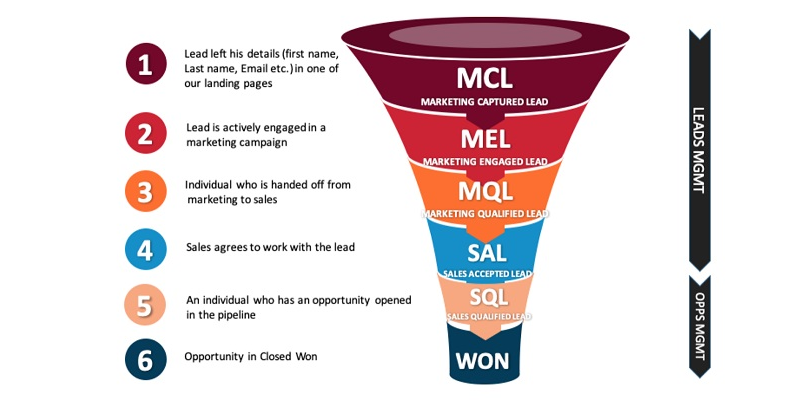
Stage 3:
Build your road map based on the lead generation funnel with your inbound and outbound marketing strategies.
Plan and strategize the content you will post on your website and social media, and configure the placement of CTAs and pop-ups to attract customers. Then, design the steps to move a lead from the top to the bottom of the funnel until they make a purchase.
This is also where you will have to strategize your lead magnets and how you can optimize them to bring in more quality leads.
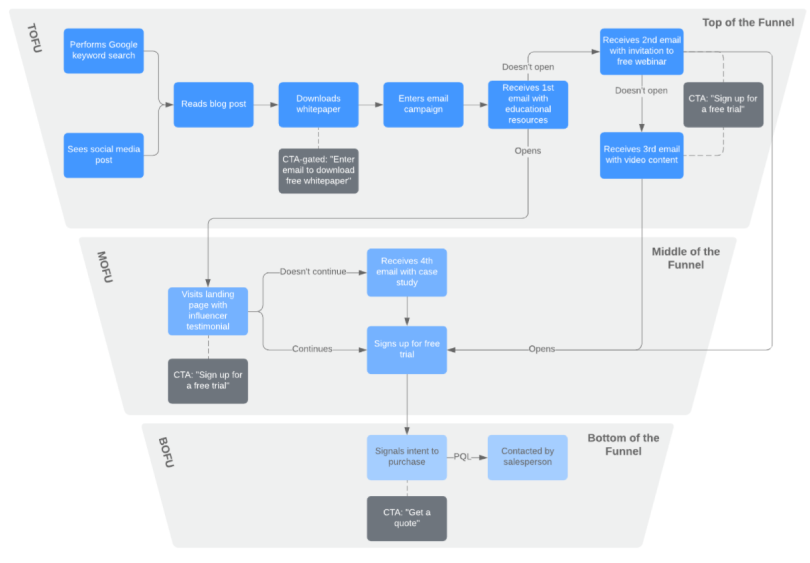
Stage 4:
At this stage, you need to use your lead scoring skills and strategies to nurture the leads so they convert as soon as possible. The above steps will help you acquire the TOFU (top-of-funnel) leads, but you also need to nurture the ones in the MOFU (middle-of-funnel).
Stage 5:
Testing is always the last but one of the most important stages in any process. No matter how robust your strategies are and how much you invest in lead generation, it’ll be all for nothing if you don’t test and iterate.
So, perform A/B testing and multivariate testing and ensure that the feedback loop between marketing and sales is kept alive. This way, you will see which actions bring better results and how customer behavior changes so you can optimize your lead generation process and strategy.
How Can Lead Generation Surveys Benefit Your Business?
Lead generation surveys can be a powerful tool for businesses. Here’s how they can benefit your business:
- Gather Valuable Insights
Surveys allow you to collect direct feedback from potential customers. This helps you understand their needs, preferences, and pain points, enabling you to tailor your products or services accordingly. - Identify Qualified Leads
By asking the right questions, you can quickly identify which respondents are genuinely interested in your offerings. This helps you focus your sales efforts on the most promising prospects. - Segment Your Audience
Surveys can help you segment your audience based on their responses. This allows you to create targeted marketing campaigns that resonate with specific groups, increasing the chances of conversion. - Enhance Personalization
The data collected from surveys can be used to personalize your marketing messages. When you address the unique needs and concerns of your leads, they are more likely to engage with your brand. - Boost Engagement
People are more likely to engage with interactive content like surveys. By incorporating surveys into your lead generation strategy, you can increase interaction and keep potential leads engaged with your brand. - Drive Content Creation
The insights gained from surveys can inspire new content ideas. You can create blog posts, whitepapers, or videos that address the topics your audience cares about, further attracting and nurturing leads. - Measure Customer Satisfaction
Surveys can be used to gauge customer satisfaction and identify areas for improvement. Happy customers are more likely to become repeat buyers and refer others to your business. - Optimize Marketing Strategies
The data from surveys provides a clearer picture of what works and what doesn’t in your marketing strategies. This allows you to make informed decisions and continuously improve your lead generation efforts.
Using lead generation surveys as part of your marketing strategy can yield valuable insights, refine your targeting, and significantly enhance the effectiveness of your lead generation campaigns.
Best Lead Generation Survey Questions to Ask
To create effective lead generation surveys, you need to ask questions that gather valuable information about your prospects while keeping them engaged. Here are some of the best questions to include:
Which industry do you deal in?

Which of our competitors did you consider before choosing [Product name]?

How much revenue do you earn annually?

Are you the decision-maker?

Which of the following topics are you most interested in learning about?

What problems are you looking to solve with [Product Name]?

- What are your top priorities in a solution?

- What is your budget?
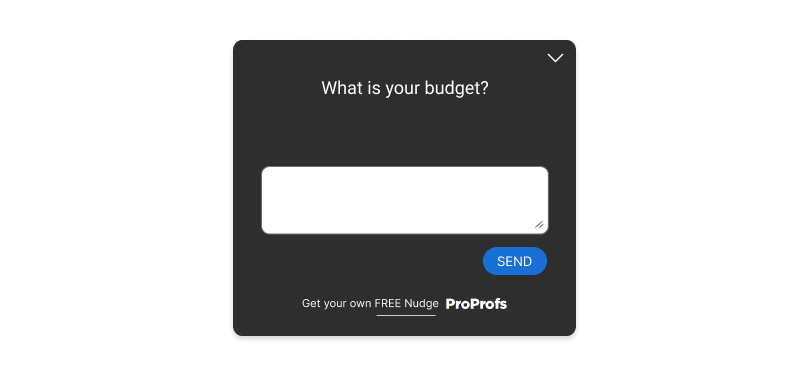
- When do you plan to make a decision?
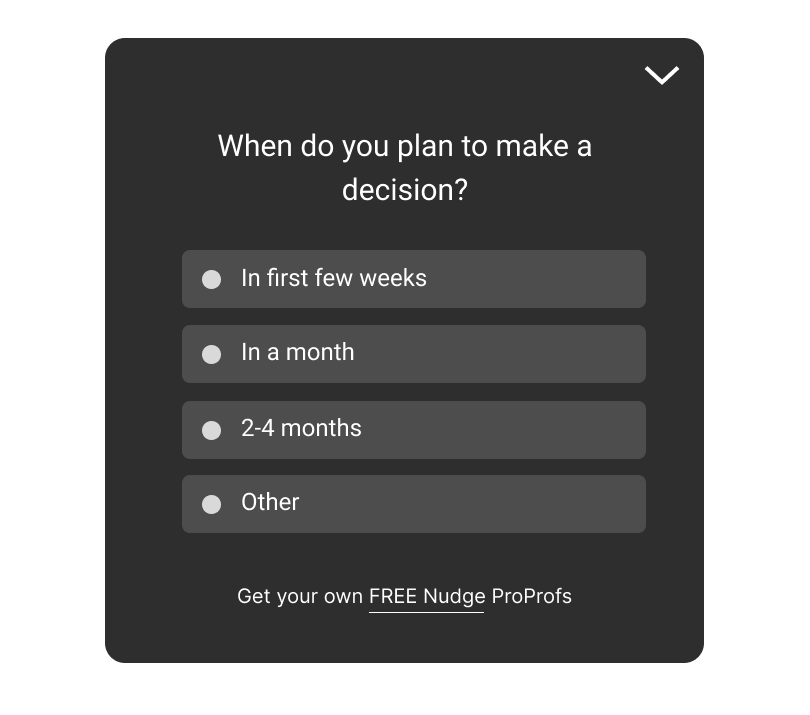
- What strategies/plans/tools do you use to deal with your problem?

- If we can do A, B, and C for you, will you buy the [product/service]?

These lead generation questions are designed to give you insight into your prospects’ needs, preferences, and decision-making processes, allowing you to tailor your offerings and communications effectively.
Tips to Instantly Increase Lead Survey Response Rates
Getting people to respond to your surveys can be challenging, but with the right approach, you can significantly boost your response rates. Here are some tips to help you get better results:
1. Multi-Channel Surveys
Why restrict your lead surveys to just one channel when you can leverage a multi-channel strategy for surveying leads?
You can target website visitors through lead generation surveys on the website, mobile apps, emails, and SMS.
You can deploy surveys in-app and on-site and share survey links in emails and SMS. This ensures that you target leads at different touchpoints and channels to convert them.
Ask Relevant Questions
Nothing puts a prospect off like a survey with many irrelevant questions. Leads are highly sensitive at the beginning of their customer journey, and even the slightest inconvenience is enough for them to churn away.
So, when you deploy your lead generation survey campaign, start with small surveys like one-question pop-ups asking only appropriate and relevant questions.
For example, instead of asking demographic questions straight away to your visitors, it’s best to ask them what they are looking for and then target them with an appropriate lead generation strategy.
2. Ask Relevant Questions
Nothing puts a prospect off like a survey with many irrelevant questions. Leads are highly sensitive at the beginning of their customer journey, and even the slightest inconvenience is enough for them to churn away.
So, when you deploy your lead generation survey campaign, start with small surveys like one-question pop-ups asking only appropriate and relevant questions.
For example, instead of asking demographic questions straight away to your visitors, it’s best to ask them what they are looking for and then target them with an appropriate lead generation strategy.
3. Incentivize the Feedback Collection
Taking surveys is no fun for many website visitors, and they may resist responding at first.
So, what can you do?
Simple- make them more exciting!
You can incentivize your lead generation surveys with access to gated content, free trial, premium features, gift cards, vouchers, time-sensitive deals, etc. In that case, they are more likely to take your surveys.
4. Employ Conditional Branching
Conditional branching and skip logic are great strategies for ensuring your leads don’t abandon the survey midway. If they keep seeing irrelevant questions, they will abandon the survey in a heartbeat.
You can prevent this by branching your questions. For example, the next question a lead will see will depend on their previous answer, and skip logic will let them skip answering the question.
This is how conditional branching works:
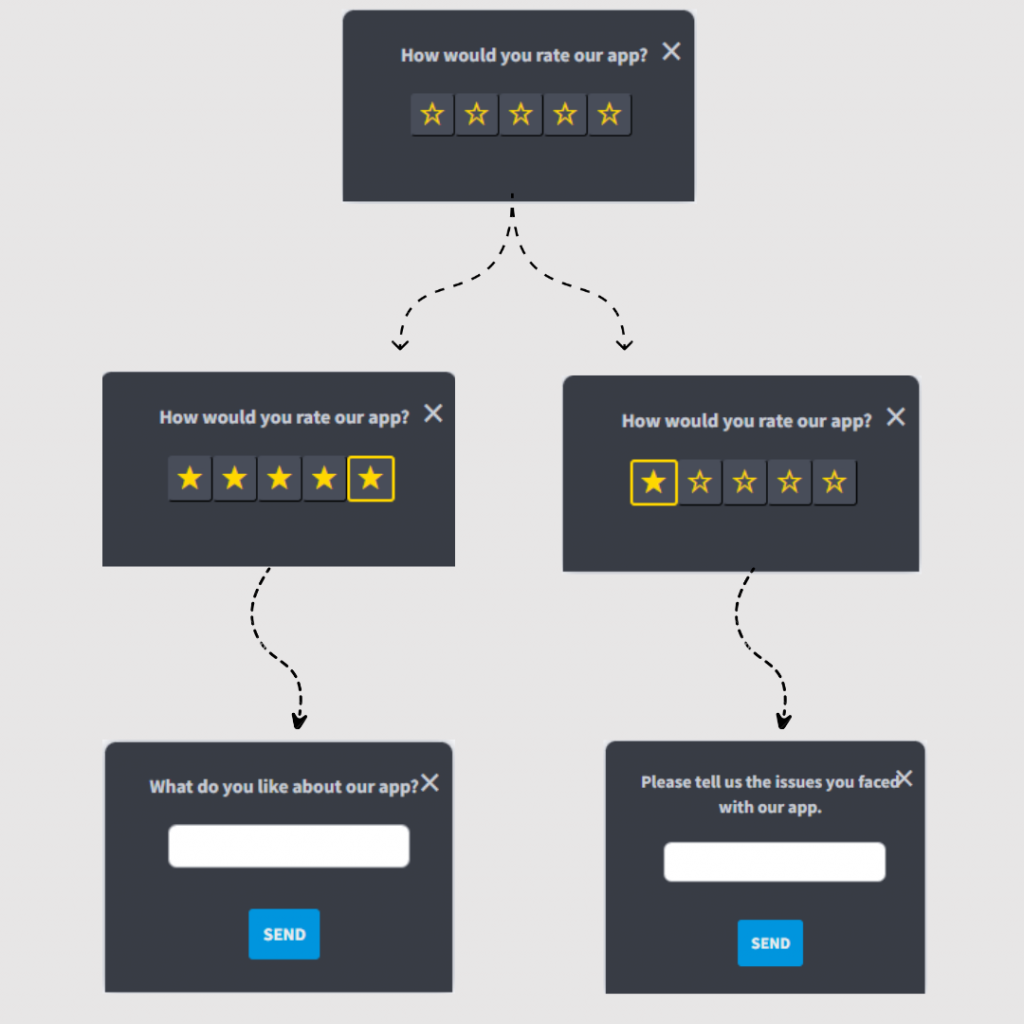
CASE STUDY: How Marketade helped its client improve user experience with branching logic
Marketade is a user research company that wanted to help one of its clients improve website usability. They specifically wanted to improve the usability in these scenarios:
- Primary care appointment booking system
- Primary care doctor selection
- Scheduling Mammogram
- Family member visit patients in the hospital
- Child food allergies research
The team used Qualaroo’s Nudge surveys and exit-intent surveys to gather feedback on the current UX and also get valuable insights from leaving customers.
The feedback enabled the team to improve the overall UX and also validate qualitative findings, among other things.
You can read about this case study here in detail.
FREE. All Features. FOREVER!
Try our Forever FREE account with all premium features!
Elevate Your Lead Generation Efforts With Qualaroo!
We hope that, having covered all these points, you’re now well-equipped with the tips and strategies necessary to develop a robust lead generation plan for your business.
If you are looking a top-notch lead generation software that effectively grows your leads and strengthens your brand’s image, Qualaroo is the name that truly excels!
With Qualaroo, you can refine your feedback collection process, gain deeper insights into user behavior, and enhance overall satisfaction—all while ensuring a smooth and unobtrusive user experience!
Learn More About Lead Generation
What is B2B lead generation?
B2B lead generation is the process of identifying and attracting potential business customers or clients for a company’s products or services. It involves strategies like content marketing, email campaigns, and networking to connect with decision-makers in other businesses.
What is the best example of lead generation?
Offering a free eBook or webinar in exchange for contact information is a great example of lead generation. This tactic attracts interested prospects, provides valuable content, and captures leads that can be nurtured into customers.
What are the three ways to generate leads?
Three effective ways to generate leads are content marketing (creating and sharing valuable content), email marketing (sending targeted messages to prospects), and social media marketing (engaging with potential leads on platforms like LinkedIn or Facebook).
What is lead generation in BPO?
In BPO (Business Process Outsourcing), lead generation involves outsourcing the task of finding and qualifying potential customers to a third-party service provider. The BPO firm handles the process of identifying prospects, allowing the client company to focus on converting these leads into customers.
FREE. All Features. FOREVER!
Try our Forever FREE account with all premium features!
 We'd love your feedback!
We'd love your feedback! Thanks for your feedback!
Thanks for your feedback!


